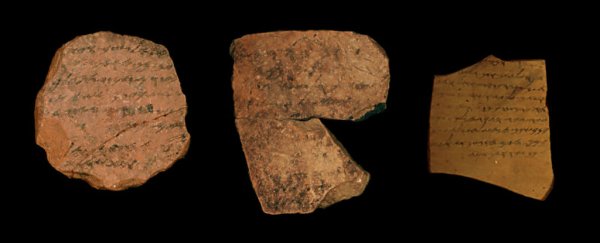Even if you're not religious, there's no denying the enormous - and sometimes devastating - influence that the Bible as an historic text has had on the world over the past 3,000 years. And yet, when it comes to the most widely distributed book on the planet, we still can't agree on who wrote it, and when.
So a bunch of mathematicians teamed up with archaeologists to shed a bit of light on the origins of the Bible, by using artificial intelligence to come up with an estimate of how many people could read and write during certain periods in ancient history.
Led by mathematician Shira Faigenbaum-Golovin from Tel Aviv University in Israel, the team came up with new image processing techniques and a handwriting recognition tool to investigate 16 inscriptions found in the desert fortress of Arad, just west of the Dead Sea.
Dated to around 600 BCE (so about 2,600 years ago) these ink inscriptions detail fairly mundane military commands and supply orders, and were written on ceramic pottery shards called ostraca during the late First Temple Period - 24 years before the Kingdom of Jerusalem was overthrown by the Babylonian king.
This is when most scholars agree that the earliest Biblical texts - including the Book of Joshua, Judges, the two Books of Kings, and parts of Genesis and Deuteronomy - were pieced together, so you'd expect that reading and writing were only common among the elite few at this time… Or were they?
To figure this out, the researchers first had to restore the inscriptions using their new image processing tools, and then used their handwriting recognition tool to determine how many people actually wrote them.
Maddie Stone explains over at Gizmodo:
"They … developed machine learning algorithms that could compare and contrast the shape of the ancient Hebrew characters in order to identify statistically distinct handwritings. In principle, this is similar to the algorithms tech companies use for digital signature detection.
All in all, their analysis revealed at least six different authors behind the 16 ostraca. Examining the contents of the text itself, the researchers concluded that these authors spanned the entire military chain of command."
"The commander down to the lowest water master could all communicate in writing," one of the team, mathematician Arie Shaus, told her. "This was an extremely surprising result."
So if the Biblical water boys were reading and writing at around 600 BCE, it suggests that a "proliferation of literacy" had already occurred much earlier, the researchers suggested, and that has implications for when the first books of Bible were likely penned.
Since the earliest biblical texts represent the political and theological ideologies of their authors, one of the team, archaeologist Israel Finkelstein, told Jennifer Viegas at Discovery News, "it makes sense that at least the literati could read them. If a large number of people could read the text, it could have been easier to distribute the ideas of the authors among the Judahite population of the time".
This could push the origin of the earliest Biblical texts back at least 200 years, archaeologist Christopher Rollston from George Washington University, who wasn't involved in this study, told Gizmodo, adding that we have good amount of archaeological evidence that suggests that parts of the Bible were written as early as 800 BCE.
The researchers are now working on developing even more tools to glean what they can from ancient texts, and it's hoped that with more evidence, we can piece together the beginnings of the best-selling book on Earth.
"We're bringing new evidence to the game," says Shaus. "Now, we'll see what else comes out."
The results have been published in Proceedings of the National Academies of Sciences.
